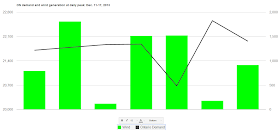You never want a serious crisis to go to waste...There's no shortage of lobbyists looking to take advantage of this crisis, but perhaps the best outcome would be to find the body/bodies most responsible for the fragility of the current system, and address the deficiencies there.
Things that we had postponed for too long, that were long-term, are now immediate and must be dealt with. - Rahm Emanuel
Toronto Hydro seems an obvious target, and I assume their staunchest critics will evaluate their performance/responsibility - as they should.
I submit the problems go far beyond the local distributor, and that the regulator bears an enormous responsibility for taking away from the Christmas of many Torontonians.
Toronto Hydro, which took far longer than it's first 72 hour estimate at getting many households powered again, has been seeking rate increases from the Ontario Energy Board (OEB) for years:
Toronto Hydro will be asking the Ontario Energy Board to reconsider a request to increase hydro rates, which was turned down earlier this month...
Toronto Hydro wanted to present its case for raising monthly hydro rates by an average of $5 a household to pay for infrastructure improvements totalling $1.5-billion over the next three years.
...upgrades are necessary to bring Toronto's grid up to modern standards. -Jan 2012



.png)
.png)